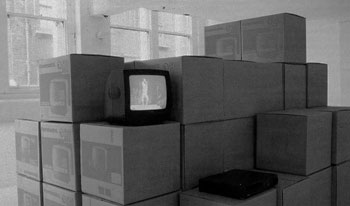Peter Zimmerman
The Agency, London
Art Monthly, Issue 213, February 1998

Image: Peter Zimmerman, Boxes
Cardboard boxes make a pretty good artistic medium. They are cheap, readily available and pack flat. What's more, they also carry a world of connotations ready for careful manipulation. They are the classic urban trash, surpassed only by plastic bags. But cardboard boxes make rather pathetic litter since they lack the immortal morbidity of toxic polyurethane. Cardboard is a mere pimple compared to the epidemic of plastic.
So cardboard boxes have a kind of utilitarian wholesomeness, a throwback to the days when mass-production didn't kill everything; plastic bags come printed with warnings about suffocating babies, but every kid loves to play in a cardboard box. You can even buy chic minimal cardboard boxes for your living room. Some people live in cardboard boxes. We agree, then, that cardboard is a good, warm material of the people - and artists such as Neil Cummings take advantage of these attributes.
Peter Zimmermann's boxes, however, are not like this. There is something less than friendly about Zimmermann's containers, something just that bit too perfect. In short, these boxes are not of the common-or-garden variety that you and I would recognise ... but impostors. For Zimmermann's boxes are corporate boxes, advertising boxes, glamour boxes. You won't find these at the soup kitchen. No, no. Rather, these boxes are fed brie and cranberry bagels as the make-up artist massages their corners into razored perpendiculars while they await the studio photographer. For these are the celebrity cardboard boxes, the boxes that appear in advertisements for their manufacturers. They are, if you will, the Alan Partridge of industrial materials.
It is important that we understand this. These are not boxes of the street but boxes of the studio. Unsullied by use, they are fake utilitarian objects. Functional but for their functionlessness, they are a kind of intellectual litter; boxes, yes, but only in theory.
In his piece Boxes, Zimmermann has screenprinted the vessels - of which there are 60 - with text. Not the text that you would normally find on the protective packaging of a 14" monitor, which these are, but text that you might encounter in a sociological discussion of television (the 'box' supreme). This text is dense, dry stuff - hard to follow. Not least because it is broken up over each container in a manner mimicking the kind of text that you would normally find surrounding a 14" monitor.
Now this text is, I think, broadly critical of televisual culture. And yet it is printed onto the very containers that protect these little monsters as they make their way into our homes. Do I smell a rat? Or even just a mouse? Is this text truly critical? Or is it mere sophistry? Perhaps this is a snipe at the not-quite-critical discussion of popular culture (mantra: popularity equals quality) which rationalises a love of trash. Perhaps the monitors arranged upon the stack, constantly flicking between cable TV channels, are meant as a celebration or as a surreptitious first taste of the drug. Perhaps not. And since the gallery could not receive the broadcasts that the piece required, it has had to make do with previously recorded videos, which doesn't make things any easier for the puzzled viewer. We find that the deeper we probe, the softer the ground gets.
There are other works too: large novajet prints from CD-ROMs. These CDs contain printing information allowing repeated reproduction or, indeed, manipulation of the works. The prints themselves contain images that have been digitally collaged, and again text splinters across the surface. From Rendering (Rendering): 'Render is a program that runs on the PC architecture which allows a user to display graphics objects on the PC monitor with precise temporal and spatial control ... '. The focus is the boxlike, indivisible elements or modular units of an actual or informational architecture. From the same piece: ' ... all this is based on the theoretical distinction between hardware (the material reality of buildings and places) and software (the impact of information and programming on this environment) ... '. Each piece is about the theoretical construction of spaces and the effect of communications upon them. There is even a nod towards hypertext, as the text which runs across the three posters of the work, Temporary Architecture/Presentation of Boxes, skips off the wall and down onto the boxes piled up below.
It is difficult to gauge Zimmermann's position in all this. We understand the area in which he is interested but we cannot pin down his particular angle with any certainty - which is perhaps deliberate. However, there is a degree of specificity about this work which suggests not only that the artist knows exactly what he is doing, but that we should too. Perhaps the intention is to leave the viewer high and dry within a confusing mass of information, but it would be a shame if this promising work set its sights so low. Certainly, Zimmermann is pressing all the right buttons. It would be great if he let us tune in too.
— End —